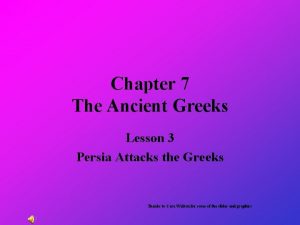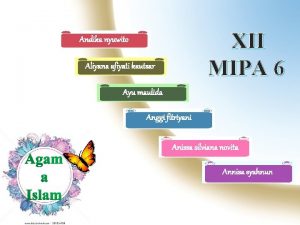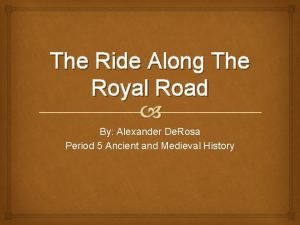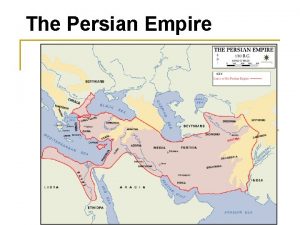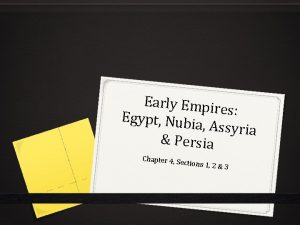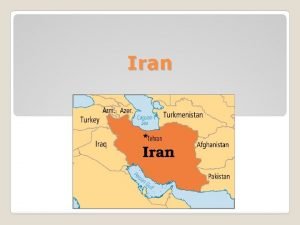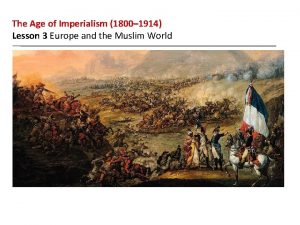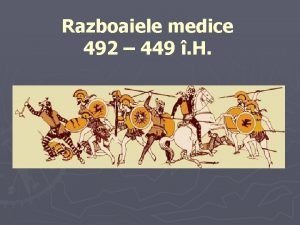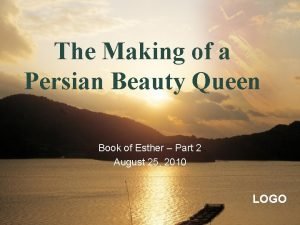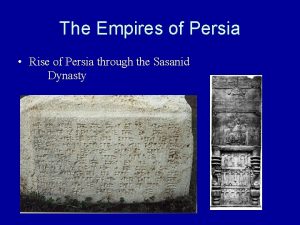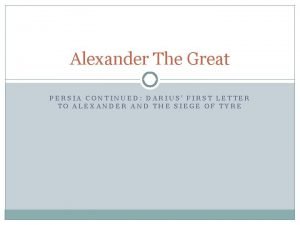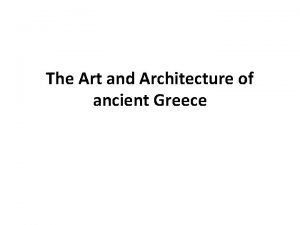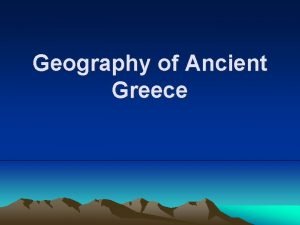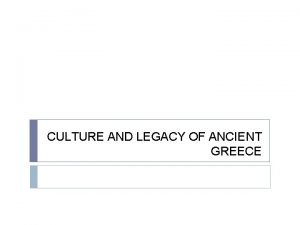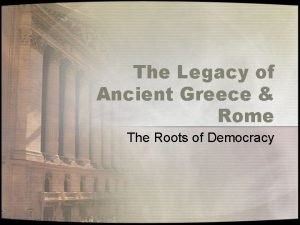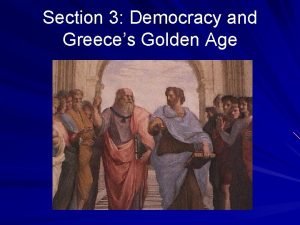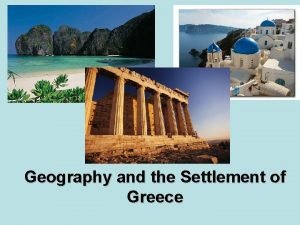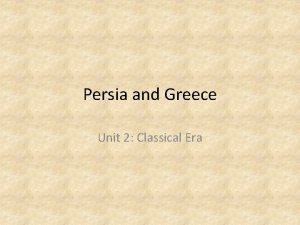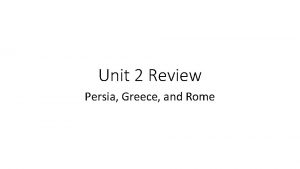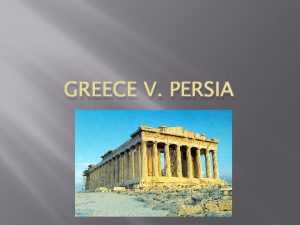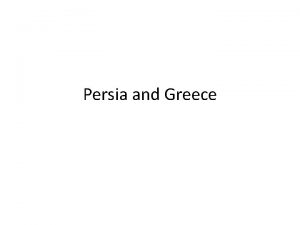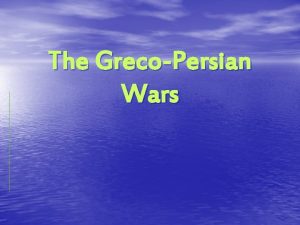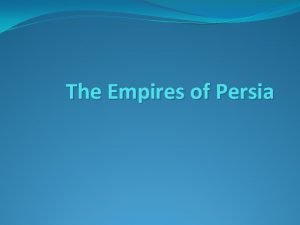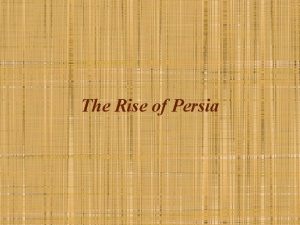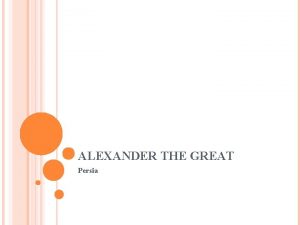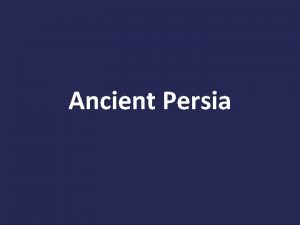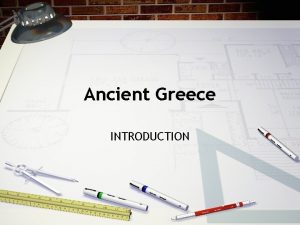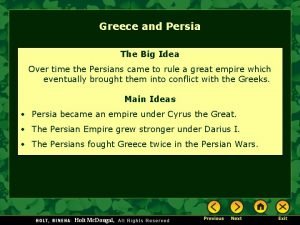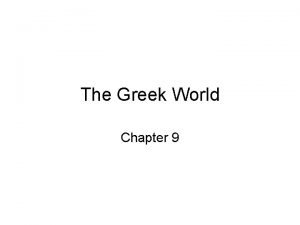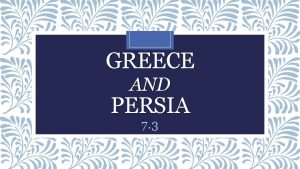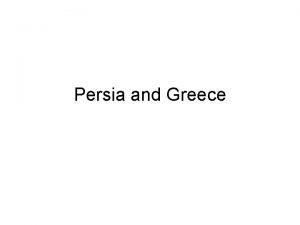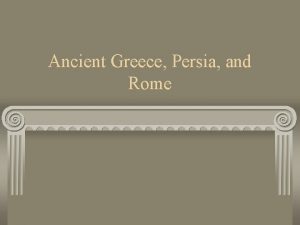Persia and Greece I Introduction A Greece and




























- Slides: 28

Persia and Greece

I. Introduction A. Greece and Persia were neighboring empires that … WHEN? ? ? B. Dual expansion led … C. Despite Persia’s defeat at the hands of the Greeks… 1. Decline 2. Legacy – Why do we focus so heavily on Greece? ? ? 3. Greece was no more important than any other classic civilization.

II. Before Persia A. Assyria (950 – 612 BCE) 1. Ruled area of ? ? ? 2. Declined because a. Empire was … b. Nobles were… c. Rebellions

II. Before Persia

III. Persia (550 – 330 B. C. E. )

III. Persia (550 – 330 B. C. E. ) CONT A. Rise 1. 2. 3. 4. Location Cyrus the Great and Darius attacks … BUT ? ? ? Xerxes a. Battle of Thermopylae 5. Battle of Salamis

III. Persia (550 – 330 B. C. E. ) CONT B. Social Structure and Culture 1. Family structure ? ? ? 2. Social Classes: What do you think they were? a. Warriors, Priests, Nobles b. Scribes, Merchants, Bureaucrats c. Peasants, Artisans 3. Language

III. Persia (550 – 330 B. C. E. ) CONT C. Religion 1. Zoroastrianism – Emphasizes ? ? ? a. Choosing between ? ? ? b. Last judgment … c. First step in the direction of …

III. Persia (550 – 330 B. C. E. ) CONT D. Political structure 1. Centralized Government HOW? ? ? a. Empire was divided into ? ? ? A. Satrapies – provinces b. Governed by ? ? ? A. B. Satraps (governors) Who were they? ? ? c. The regions paid tribute to the king WHAT? ? ? d. Conquered peoples had … Led to WHAT? ? ? 2. Government built ? ? ? WHY? ? ? a. Increased trade and to control the empire b. **FUN FACT ALERT** Led to ? ? ?

III. Persia (550 – 330 B. C. E. ) CONT E. Decline – Defeat in 477 B. C. E. to ? ? ? 1. Played small role in … BUT … Persian War

IV. Classical Greece (500 – 338 BCE) and Hellenistic Empire (323 – 30 BCE) A. Geography 1. ? ? ? 2. Lacked ? ? ? Led to ? ? ? 3. Natural barriers led to … a. No central government 4. Also led to … 5. Hellenistic empire



IV. Classical Greece (500 – 338 BCE) and Hellenistic Empire (323 – 30 BCE) B. The Emergence of City-States (Poli) 1. Featured ? ? ? a. Stress on … 2. City-States competed for ? ? ? 3. Two strongest city-states ? ? ? fought in … a. Who wins? ? ? b. Who REALLY wins? ? ? 1) Weakened Greek unity 2) Conquered by ? ? ? a) King Philip of Macedonia b) Alexander the Great




IV. Classical Greece (500 – 338 BCE) and Hellenistic Empire (323 – 30 BCE) C. Religion 1. Polytheistic religion featuring … 2. Little appeal among the commoners since it lacked “mystery. ” a. What does “mystery” mean? ? ? b. Hellenistic age produces many mystery religions 3. No major religion established differs from ? ? ?

IV. Classical Greece (500 – 338 BCE) and Hellenistic Empire (323 – 30 BCE) D. Politics – Birth of ? ? ? 1. Expansion of trade led to … 2. Eventually led to ? ? ? a. Caused a shift in people’s allegiance from … b. Led to wide-spread participation in government – DEMOCRACY c. Does everyone vote? ? ? Can anyone be a politician? ? ? WHY? ? ? 3. Level of democracy varied a. Athens? ? ? Sparta? ? ?

IV. Classical Greece (500 – 338 BCE) and Hellenistic Empire (323 – 30 BCE) E. Greek Society 1. Patriarchal – BUT… 2. Slavery

IV. Classical Greece (500 – 338 BCE) and Hellenistic Empire (323 – 30 BCE) F. Greek Culture 1. Large cultural gap … 2. Based on four principles: 1) 2) 3) 4) Emphasis on ? ? ? Art and sculpture glorified ? ? ? Drama and philosophy stressed … The philosophical and scientific tradition emphasized ? ? ? 3. Major Philosophers? ? ?




IV. Classical Greece (500 – 338 BCE) and Hellenistic Empire (323 – 30 BCE) G. Decline 1. Alexander creates …

IV. Classical Greece (500 – 338 BCE) and Hellenistic Empire (323 – 30 BCE) 2. After Alexander’s death, the empire declined… WHY? ? ? 3. Hellenistic Age a. Blending of … 4. Hellenistic Kingdoms a. b. c. d. Macedonia – Antigonid Dynasty Syria & East – Seleucid Dynasty Pergamum – Attalid Dynasty Egypt – Ptolemy Dynasty


V. Conclusion A. Greeks did not develop ? ? ? Who did? ? ? 1. Democracy of Greeks was … 2. In 1700 s used to justify establishing own forms of democracy B. Legacy was … 1. Citizenship 2. Heritage of Slavery 3. Art and Philosophy – Most Lasting Contribution a. KEY IDEA – Ordinary People… 4. Fundamental in developing Middle Eastern and Western Civilization
 Lesson 3 greece and persia
Lesson 3 greece and persia Babylon medo-persia, greece rome timeline
Babylon medo-persia, greece rome timeline Teori mekah
Teori mekah Royal road in persia
Royal road in persia Persian army
Persian army Persia antica
Persia antica Aassyria
Aassyria How did darius i change persia's political organization?
How did darius i change persia's political organization? Persia 1935
Persia 1935 How were efforts to westernize problematic
How were efforts to westernize problematic Discovery of oil in persia
Discovery of oil in persia Principe de persia
Principe de persia Razboaie medice
Razboaie medice Las cuatro bestias
Las cuatro bestias Persia beauty queen
Persia beauty queen Rise of persia
Rise of persia Tyre alexander
Tyre alexander عبدل آباد
عبدل آباد Essay structure introduction
Essay structure introduction Ancient greek homes
Ancient greek homes Differences between athens and sparta
Differences between athens and sparta Greece
Greece Ancient greece geography map
Ancient greece geography map The capital and largest city of greece
The capital and largest city of greece The grandeur that was greece
The grandeur that was greece What can we learn from studying ancient greek artwork
What can we learn from studying ancient greek artwork The legacy of ancient greece and rome
The legacy of ancient greece and rome Democracy and greece's golden age
Democracy and greece's golden age Geography and the settlement of greece
Geography and the settlement of greece
